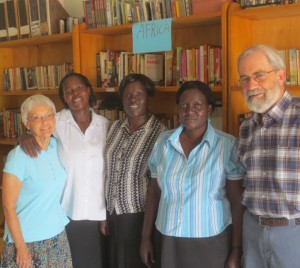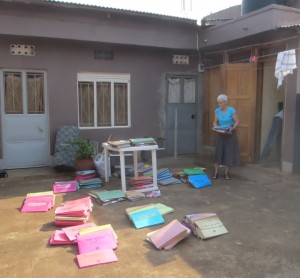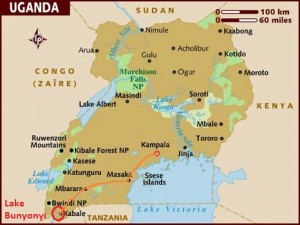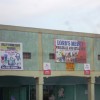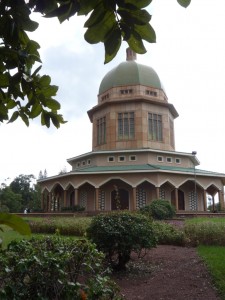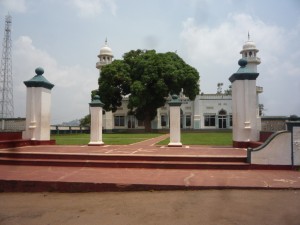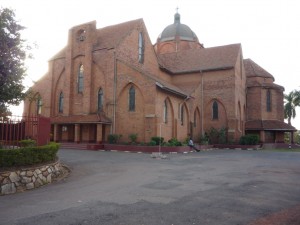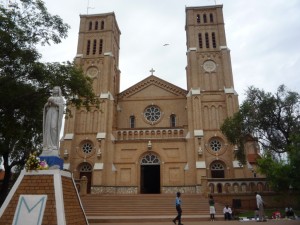Return to Uganda
Saturday, January 25th, 2014In early January we were happy to leave the “Polar Vortex” which had invaded northern Indiana and head to sunny warm Uganda again. The experiences of our two-day travel are hopefully never to be repeated—everything went wrong which could have gone wrong! However, after 15 hours of uninterrupted sleep after we finally arrived, we were very happy to be back “home” here.
We are being lodged in a quiet hotel near where we formerly lived. We have a huge room with a sitting area and a small kitchen which includes a “cold-drinks-type” refrigerator placed in a walk-in closet. Every day the person who cleans our room folds the blankets, arranges the pillows, and adds a flower/green to our bed in a different way. We have taken a couple of walks in the area; there are many large up-scale homes. We have noticed changes in the past 1 ½ years in the city where we are located. Right now the air quality is extremely bad; there is a constant deep haze which makes it difficult to see the hills sometimes. New construction is still going on everywhere. The big noticeable place for us was near the office. When we left, they were digging a large hole and now there is a huge 5-storey mall nearly finished. Some roads that we often drove on have been repaired. A number of the street vendors have been cleared out but Friday market in Kamwokya is the same.
It has been fantastic to meet so many of our friends again. The first day we were here, Maureen came to visit us. She is going to school to become a Public Health Worker and is enjoying it.
The office staff have changed some in the past 1 ½ year but again so good to see them. We were able to contact and visit with others who have recently left the office. We also were able to visit with or at least talk on the phone with several Uganda partners. And of course, it was fun to meet up with Stephen and Deanna during their time in Kampala.
During the work week our standard day begins with a large breakfast here at the hotel. It has been the same for 17 days! It is good but big so that after the first morning we asked for ONE breakfast which we share and 2 coffees.
We begin with a plate of fresh fruit (mango and pineapple), followed by a Spanish omelet, meat (either bacon or sausage—and there is a lot!), garnish of tomato and cucumber, toast, and coffee. We get to the office about 8:30, work, lunch at nearby restaurants, work, back to the hotel about 5, tea, games, and a salad supper which we make ourselves. We have gone out for several great evenings also!
Oh yes, we did come to work! Our first day was to empty the storeroom of all the old files which had been “dumped” here and do a broad sort by years.
We returned any financial files for the last 7 years to the storeroom to be kept for auditing purposes. During the rest of our two weeks we sorted by partner or organization. Any financial receipts (older than 7 years) could be burned. We found folders labeled wrongly or filled with a variety of topics. We had stacks and stacks of papers not even in folders. But at the end of two weeks we had most things sorted, labeled, and some files even in chronological order. More work could be done but we feel we made progress. We did spend one day sorting and organizing a box of South Sudan files to be sent back to Akron. When we finished we had a large 30” x 60” x 30” container full of material that needed to be either shredded or burned because it had names, contact information, or financial information on it. We wish we were here for the bonfire! And that doesn’t take in to account the many waste baskets we filled and emptied with material that went out to the trash because it was not “sensitive” documents.
Now on to Arusha, Tanzania!
- hotel neighborhood
- hotel neighborhood
- new mall being built
- Kamwokya market
- our room
- our refrigerator
- our bed
- another design
- Maureen
- office staff
- 7-week old Amarisa
- lunch for 4!
- Cristabelle loves the book
- Susan
- Meshack has grown
- Sr Sophia
- happy couples
- breakfast-first course
- rest of breakfast
- Rolex and mint drink
- mango drink
- tea time
- game time
- salad supper
- grilled tilapia
- beginning project
- sorting & organizing
- more organizing
- completion!
- to be burnt
- storm coming


